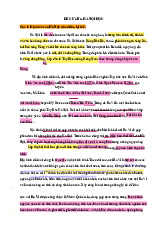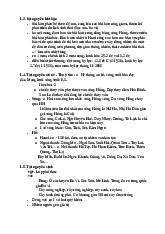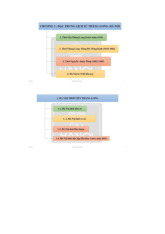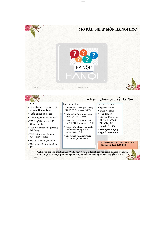
















Preview text:
lOMoARcPSD|46958826 lOMoARcPSD|46958826
OVERVIEWS | ANSWER EXPLANATIONS | TIPS
STRATEGIES | MODEL ANSWERS... AND MUCH MORE! IELTS MOCK TEST Listening Reading Writing Task 2 Writing Task 1 for Academic Writing Task 1 for General Speaking Next Steps FILLABLE TEST BOOK + ANSWER SHEET
*Complete this mock test with the associated
"E2 I ELTS" YouTube video: bit.ly/E2IELTSMockTest lOMoARcPSD|46958826 Get Ready to Succeed! Prepare for your IELTS
E2 Test Prep has helped 1.5 million candidates pass their high-stakes success
English exams through its powerful methods, exam-like practice Click here
questions, live group classes, 1:1 tutorials, speaking and writing feedback and simulated Mock Tests.
This mock test gives you a full exam-like experience with guided
instructions from two expert teachers - Jay and Mark. Contents The mock test is just like the real thing! Jay and Mark took me through every 1 Listening 4 Siraj, E2 part of the test 2 Reading 11 stu ent and showed me exactly what to do on 3 Writing Task 2 24 test day. 4 Academic Writing Task 1 26 Amazing! 5 General Writing Task 1 28 Juan, E2 student 6 Speaking 30 7 Next Steps 31
Click to watch the IELTS Mock Test video on YouTube
Copyright C 2021 www.e2language.com- Al rights reserved 1 lOMoARcPSD|46958826 IELTS Academic Packages
We’ve prepared over 1.5 million test takers for their exam success
and we can help you too. Our expert teachers will guide you every
step of the way to achieve the score you need.
Copyright C 2021 www.e2language.com- Al rights reserved 2 lOMoARcPSD|46958826 IELTS General Packages
We’ve prepared over 1.5 million test takers for their exam success
and we can help you too. Our expert teachers will guide you every
step of the way to achieve the score you need.
Copyright C 2021 www.e2language.com- Al rights reserved 3 lOMoARcPSD|46958826 IELTS Listening Part 1
Questions 1 – 3
Complete the form below.
Write ONE WORD AND/OR A NUMBER for each answer.
Vista View Real Estate: Tenant Preferences Name: Andre Peterson Example Answer No. of bedrooms three / 3 Preferred location:
in the 1 _____ area of the city Maximum weekly rent: 2 $ _____ Lease length preferred: 3 _____ Start of lease: November 10th
Questions 4 – 8
Complete the table below.
Write ONE WORD AND/OR A NUMBER for each answer. _____ ___ ___ ___ ___
Copyright C 2021 www.e2language.com- Al rights reserved 4 lOMoARcPSD|46958826
Questions 9 – 10
Choose TWO letters, A-F
Which TWO after school programs does Highfield Grammar offer? 9 ____ 10 ____ A French B racket sports C chess D science E swimming F art IELTS Listening Part 2
Questions 11 – 16
Choose TWO letters, A-E
Which TWO facilities are currently NOT available at the gym? 11 ___ 12 ___ A tennis courts B elevator C sauna D change rooms E swimming pool
Which TWO classes will run today? 13 ___ 14 ___ A pump B boxing C active seniors D yoga E dance
Which TWO classes will be advertised next month? 15 ___ 16 ___ A water safety for babies B weight loss C body combat D meditation E grit strength
Copyright C 2021 www.e2language.com- Al rights reserved 5 lOMoARcPSD|46958826
Questions 17 – 20
Label the map below. Write the correct letter, A-G, next to Questions 17-20. AREAS OF GYM 17 swimming pool _____ 18 training rooms _____ 19 tennis courts _____ 20 shop _____
Copyright C 2021 www.e2language.com- Al rights reserved 6 lOMoARcPSD|46958826 IELTS Listening Part 3 Questions 21-26
Complete the sentences below.
Write no more than TWO WORDS AND/OR A NUMBER.
The Potato Eaters reminds the man of art pieces by the 21 _____.
The man thinks Van Gogh’s use of 22 _____ makes his work distinct.
Apparently, Van Gogh established a 23 _____ for other artists.
The woman mentioned that Gauguin was 24 _____ with his use of colours.
The man likes Starry Night because of the 25 _____ of the paint.
The students agree it is sad that Van Gogh was 26 _____ while alive. Questions 27-30
What is the key information that should go into each section of the presentation?
Choose FOUR answers from the box and write the correct letter A-E next to Questions 27-30. 27 Section 1 _____
Plan for the presentation 28 Section 2 _____ A early life B power of his art 29 Section 3 _____ C period in France D major works 30 Section 4 _____ E mental health
Copyright C 2021 www.e2language.com- Al rights reserved 7 lOMoARcPSD|46958826 IELTS Listening Part 4
Questions 31 – 33
Choose the correct letter, A, B or C.
31 Mosquitos can multiply in uncared for _____ A roof gutters B swimming pools C rainwater tanks
32 How many varieties of mosquito are found in and around Australian homes? _____ A hundreds B thousands C a few
33 Which is the most common mosquito related disease in Australia? _____ A dengue B Ross River C Barmah Forest
Copyright C 2021 www.e2language.com- Al rights reserved 8 lOMoARcPSD|46958826 Questions 34 – 40
Complete the flow chart below. Write NO MORE THAN TWO WORDS AND/OR A
NUM-BER for each answer.
Life Cycle of a Mosquito Egg Stage Larval Stage Pupal Stage Adult Stage Females search for Larvae move to the Pupae stop eating Adult mosquito stil water or surface to breathe. and shedding skin. initially rests. 34 ________ to lay eggs. Some larvae siphon During development, 39 __________ dries oxygen while they move and react and strengthens. Eggs form a kind of others attach to 36 to 38 __________
‘raft’ of around 200 __________. alterations. 40 __________ eggs. eventual y unfurl. Main form of Resembles Most eggs hatch caterpil ar-butterfly nourishment are 37 Begin feeding and inside 35 __________ process. __________ mating almost immediately. Process usual y lasts Larvae shed their for two days. Lifecycle continues. skins four times to continue growing. Metamorphosis results in emergence of adult mosquito. IELTS
IELTS Listening Mock Test Scoring
What’s your listening score? score _______ *Estimated Score out of 40 IELTS Band Score 12, 13, 14, 15 4 16, 17, 18 5 19, 20, 21, 22 5.5 23, 24, 25 6 26, 27, 28, 29 6.5 30, 31, 32 7 33, 34 7.5 35, 36, 37 8 38, 39 8.5 40 9
Copyright C 2021 www.e2language.com- Al rights reserved 9 lOMoARcPSD|46958826
IELTS Listening Answer Sheet Module taken: Academic: ___ General Training: ___ 1 21 2 22 3 23 4 24 5 25 6 26 7 27 8 28 9 29 10 30 11 31 12 32 13 33 14 34 15 35 16 36 17 37 18 38 19 39 20 40
Watch the Teacher-guided Full Mock Test video
on YouTube. Subscribe to E2 IELTS.
Copyright C 2021 www.e2language.com- Al rights reserved 10 lOMoARcPSD|46958826 Reading Section 1 INUIT CLOTHING
A. The Inuit are a group of cultural y related indigenous peoples who inhabit the
Arctic areas of Canada, Greenland and the United States. These areas are
some of the coldest in the world to live in. Traditional Inuit clothing is a complex
col ection of cold-weather garments consisting of jackets, pants, mittens, inner
footwear and outer boots. Inuit clothing was designed to guard against the
freezing cold in several ways. Each garment was individually tailored to the wearer’s
body with complex sewing techniques. Caribou fur, which was often
used, is an excellent material to maintain warmth; the hollow structure of caribou
hairs helps trap warmth within individual strands, and the air that gets trapped in
between the hairs also retains heat. Garments were also generally bell-shaped
to prevent the rising warm air from escaping, and openings minimised to prevent heat
loss, but in the event of overheating, the hood could be loosened to al ow heat to
escape. Hoods were an important feature of the jacket, where hairs from wolves,
dogs or wolverines were used to shield the face from high velocity freezing winds.
Layers were also an important aspect of the construction that reduced drafts.
B. Even in the freezing conditions, the Inuit would still perspire, which would eventually
lead to the accumulation of moisture inside their garments which had to be managed.
The careful y tailored layers of the clothing would allow fresh air
to circulate, especial y during intense physical exertion, removing air saturated with
perspiration and keeping the Inuit’s bodies and garments dry. The animal
skins used as the outer layer were also quite porous, allowing some moisture to
evaporate. If moisture would accumulate on the surface of the garments, it would
freeze as crystals and could be brushed or beaten away. The moisture of the
Inuit’s breath would freeze on the fur of the hood and could also be brushed off
with one hand. With regard to footwear, animal skins are superior to nonporous
materials such as modern-day rubber or plastic at allowing moisture to escape,
keeping the feet drier and warmer. Animal skins also al ow for greater flexibility in
freezing conditions because unlike woven materials, they do not absorb moisture and
freeze to the wearer’s body.
C. Making clothing that was impervious to the wet was a major concern for the Inuit,
especial y during summer when rain was more frequent. The skin of marine mammals
such as seals sheds water naturally and is relatively light and breathable, making it
ideal for this type of clothing. Before artificial weather-proof fabrics became available,
the intestines of walruses were used to make raincoats and other wet-weather gear.
While seams are general y areas in clothing that can
Copyright C 2021 www.e2language.com- Al rights reserved 11 lOMoARcPSD|46958826
be prone to leaking, skilful sewing techniques, especial y in footwear, allowed the Inuit to keep dry.
D. Inuit garments were tailored in such a way that they would allow the wearer to
perform their work without encumbrance. Because the Inuit typically divided their work
by gender, men and women had distinctly different clothing styles. A man’s
coat which was meant to be worn while hunting would provide additional shoulder
room for unrestricted movement while also allowing the male wearer to pull their arms
into the garment to maintain warmth. The long back flap would also cover the hunter
while he crouched for long periods of time waiting for an animal. For women, some of
their garments included a pouch for carrying infants. For both genders, the garments
could be donned rapidly if need be, and the hoods were constructed to provide warmth
while maximising peripheral vision.
E. Creating clothing from animal skins is very labour-intensive and a highly customised
process, and can only be done at certain times of the year when the skins become
available. As such, it was critical to create clothes that would survive day-to-day wear
and tear. Thought of another way, Inuit clothing was not easily replaceable. To
minimise stress to the skins, seams were placed strategical y. In the jacket, for
example, the shoulder seam is off the shoulder. On the trousers, the seams are placed
on the side of the legs. Different cuts of animal
skin were used according to their individual sturdiness. Hardier skin from the animal’s
legs were used for mitts and boots, which need to be as indestructible as
possible, while more rubbery skin from the animal’s shoulder would be used for
a jacket’s shoulder, which required suppleness. If an item of clothing tore, then it
would be fixed as soon as possible, including in the field, if necessary.
Looking for more IELTS reading materials?
Check out www.e2language.com’s IELTS preparation courses and live classes. Our
methods, practice materials and expert teachers will help you improve reading
skills and boost your confidence and score.
START 30 DAY FREE TRIAL
Copyright C 2021 www.e2language.com- Al rights reserved 12 lOMoARcPSD|46958826 Questions 1 - 5
The text has five paragraphs. Choose the correct heading for each paragraph from the
list of headings below. Write the correct number i-viii in boxes 1-5 on your answer sheet. List of Headings i Functional Form ii Humidity Control
iii Decorative Techniques iv Waterproofing v Durability vi Ceremonial Clothing vii Production Process
viii Insulation and Heat Conservation 1. Paragraph A ____ 2. Paragraph B ____ 3. Paragraph C ____ 4. Paragraph D ____ 5. Paragraph E ____
Questions 6 – 12
Complete the sentences below.
Use NO MORE THAN ONE WORD from the passage.
6. Because caribou hair is _________ it retains heat and keeps warmer for longer
7. The design of the Inuit garments was typical y _________ so that rising heat would not easily disperse.
8. Animal skins are effective at managing sweat via airflow because they are _________
9. Unlike woven materials, animal skins provide the wearer with more _________
because they don’t become stiff.
10.Traditional y, walrus _________ were used to make wet weather clothing
11.Men’s coats had loose-fitting _________ areas so they could hunt more easily.
12.To carry babies, women’s clothing sometimes incorporated a _________.
Copyright C 2021 www.e2language.com- Al rights reserved 13 lOMoARcPSD|46958826 Questions 13 - 16
Does the information in the statements match the information in the passage?
Choose TRUE if the statement agrees with the information.
Choose FALSE if the statement contradicts the information.
Choose NOT GIVEN if there is no information on this statement.
13.Nowadays, Inuits use synthetic waterproof materials instead of traditional sea mammal skins. ________
14.A design constraint meant that Inuit hoods were warm but limited wide angle vision. ________
15.In general, women sewed most of the clothes. ________
16.Damaged clothes, including tears, would sometimes be fixed while outdoors. ________
-------------- END OF SECTION 1 --------------
Looking for more reading materials?
Check out www.e2language.com’s IELTS preparation courses and live classes. Our
methods, practice materials and expert teachers will help you improve reading
skils and boost your confidence and score. START STUDYING WITH E2
Copyright C 2021 www.e2language.com- Al rights reserved 14 lOMoARcPSD|46958826 Reading Section 2
Telling the Time Using Water Clocks
A water clock is any timepiece by which time is measured by the regulated flow of
liquid into (inflow type) or out from (outflow type) a vessel. EGYPT
The oldest water clock of which there is physical evidence is Egyptian. These simple water
clocks, which were of the outflow type, were stone vessels with sloping sides that al owed
water to drip at a nearly constant rate from a small hole near the bottom. There were
twelve separate columns with consistently spaced markings on the inside to measure the
passage of “hours” as the water level reached them. These clocks were used by priests to
determine the time at night so that the temple rites and sacrifices could be performed at the correct hour. BABYLON
In Babylon, water clocks were of the outflow type and were cylindrical in shape and aided
astronomical calculations. While there are no surviving water clocks from this region,
evidence of their existence comes from writings on clay tablets. These clocks were
unique, as they did not have an indicator such as hands (as are typically used today) or
grooved notches (as were used in Egypt). Instead, these clocks measured time by the
weight of water flowing from them. INDIA
Pots excavated from the Indus Valley site of Mohenjo-daro were used as water clocks.
They are tapered at the bottom, have a hole on the side, and are similar to the utensil
used to perform various religious rituals. Four-hour long intervals were measured,
which consisted of a similar copper bowl holding two large floats in a larger bowl fil ed
with water; it sank when completely filled and was marked by the beating of a drum throughout the day. KOREA
In 1434, Chang Yongsil, who was a palace guard and later chief court engineer,
constructed a self-striking hydro-mechanical water clock. This innovation no longer
Copyright C 2021 www.e2language.com- Al rights reserved 15 lOMoARcPSD|46958826
required the reliance of human workers, known as “rooster men”, to constantly replenish
the water. The uniqueness of the clock was its capability to announce the time with both
visual and audible signals. This water clock was not preserved well and did not survive;
however, reconstructions based on text descriptions have been made.
As the water from the upper containers seeped down to the lower jar via spouts, the water
would then rise to a set position, pushing a cork prong upwards through a cylindrical tube,
tilting a floating rod, triggering the release of a ball bearing through a smal outlet, which
would rol down a pipe to a container of iron balls. The col ision would cause them to travel
along a lower pipe and would mark the hour automatically with the sounds of a bel , drum, and lastly, a gong. PERSIA
The use of water clocks in Iran dates back to the beginning of the millennium. They were
used to determine the shortest, longest, and equal-length days and nights of the years.
Persian water clocks consisted of a large pot full of water and a bowl with a small hole in
the centre. When the bowl became full of water, it would sink into the pot, and the clock
manager would empty the bowl and again put it on the top of the water in the pot. He would
record the number of times the bowl sank by putting small stones into a jar. GREECE
The Greeks introduced several types of inflow clocks and invented an indicator
system typical for later clocks such as the dial and pointer. They also designed one of the
world’s first alarm clocks, working with gongs or trumpets. A commonly used water
clock was the simple outflow one. This small earthenware vessel had a hole in its side near
the base. In both Greek and Roman times, this type of water clock was used in
courts for allocating periods of time to speakers. In important cases, such as when a
person’s life was at stake, it was filled completely, but for more minor cases, only partially.
Copyright C 2021 www.e2language.com- Al rights reserved 16
Copyright C 2021 www.e2language.com- Al rights reserved lOMoARcPSD|46958826
Questions 17 - 24
Match each statement with the name of the country / region.
Choose the correct letter A – F for questions 17 – 24.
NB You may use any letter more than once.
17. This water clock resembled a tool used in religious ceremonies. ______
18. This type of water clock has since been recreated according to old texts. ______
19. The time allowed to settle a dispute was kept by these water clocks. ______
20. Someone would have to manually keep track of the time using pebbles with these water clocks. ______
21. These water clocks helped to measure the movement of celestial objects. ______
22. The task of refilling water was automated, and human labour made
redundant, by these water clocks. ______
23. Ancient writing imprinted in clay describes these water clocks’ existence. ______
24. One such water clock was devised to wake people up. ______
List of Countries / Regions A. Egypt B. Babylon C. India D. Korea E. Persia F. Greece
See next page for questions 25 - 31
Copyright C 2021 www.e2language.com- Al rights reserved 17 lOMoARcPSD|46958826
Questions 25 - 31
Label parts of the water clock on the diagram below. Choose your labels given with the diagram. 25. _________________ 26. _________________ 27. _________________ 28. _________________ 29. _________________ 30. _________________ 31. _________________ Clock Parts cork prong cylindrical tube containers gong lower pipe bell floating rod jar drum spouts pipe iron ball ball bearing outlet
Copyright C 2021 www.e2language.com- Al rights reserved 18






